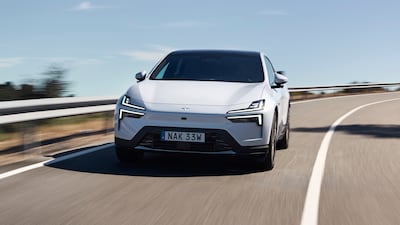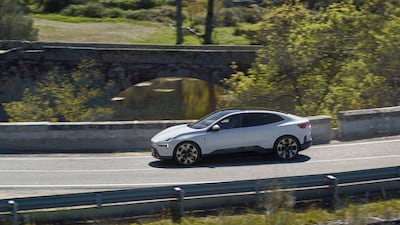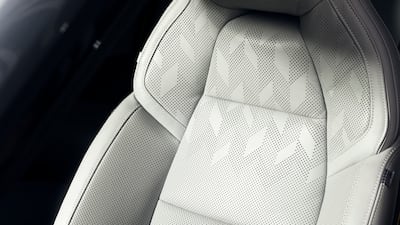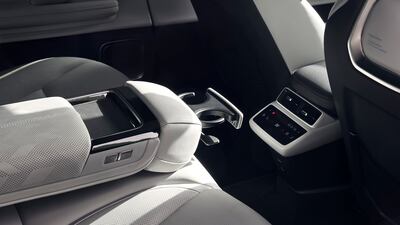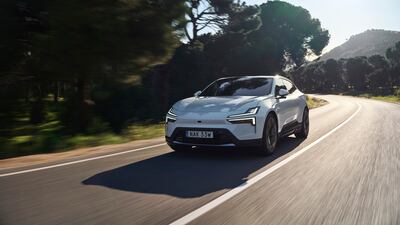Polestar, the electric car manufacturer that began life in Sweden not so many moons ago, isn’t a company that wastes a lot of time thinking of names for its vehicles.
So far, it’s all about the numerals, with the brand’s roster including the 2, 3, 4, 5 and 6. They haven’t been revealed in that order – we’ve already seen what the 5 and 6 will look like even though they aren’t yet available to buy.
Earlier this year, the 3 was released and now it’s the turn of the 4. Within the Polestar hierarchy, higher digits are not an indicator of a better car. The 4, therefore, has been nudged in as a mid-range SUV option between the 2 and the 3.
So far, so numerical.
The most obvious thing to say about any Polestar thus far is that they’re modern. Ultra-modern, in fact. The cars all have a futuristic feel about them, resembling some of the vehicles sci-fi films and TV shows have envisaged over the years.
The 4, needless to say, is every bit one of the breed. Its sloping, SUV-coupe shape is distinctly aesthetically pleasing, almost giving the impression it’s been crafted from porcelain.
When you get inside, there is no hint of the past, either – everything looks like it has been designed to try and overwrite anything automotive that has come before.
A notable example is the backward-facing camera whose footage is fed through to the electronic driver’s mirror. We’ve seen this kind of set-up in other cars, but Polestar has taken the concept one step further by having no back windscreen at all. It's just a black shell back there.
The specs
Engine: Long-range single or dual motor with 200kW or 400kW battery
Transmission: Single-speed automatic
Max touring range: 620km / 590km
Price: From Dh250,000 (estimated)
I feared this might make for a claustrophobic driving experience, but there is none of that. The general effect is cosiness. Few who have seen this feature would be surprised if it were adopted by other manufacturers in their own models over the next couple of years.
Meanwhile, the driving experience can best be described as composed and serene. Lack of engine noise aside, the 4 has an unhurried air that is almost diametrically opposed to the feelings you get in, say, a muscle car.
That said, if you opt for Polestar’s fastest version, this vehicle can get up to 100kph from a standing start in about 3.8 seconds. Performance of this sort would leave most muscle cars utterly floundering.
There is also plenty of room inside. In a strange bit of trickery, the 4, much like the 3, feels considerably bigger on the inside than it looks on the outside. As expected, a car of this has some decent tech.
Along with a neat head-up display, the 4 comes with a 15.4-inch centre display, a 10.2-inch driver display and a rear climate and entertainment control screen. Sound comes courtesy of a Harman Kardon audio set-up with up to 16 speakers.
Buyers will get a reasonable amount for their cash with a 4. Other Swedish manufacturers – notably Volvo and, in the past, Saab – traditionally produced high-quality vehicles, but they came at a cost.
Regional pricing has yet to be confirmed, but expect a base model 4 to cost somewhere in the region of Dh250,000 ($68,000). That price tag is likely to make it a serious option for those after an electric SUV, particularly if looking for something a little bit different.
And different – in a good way – is certainly an accurate way to describe the futuristic 4.
Company%20Profile
%3Cp%3E%3Cstrong%3ECompany%3A%3C%2Fstrong%3E%20Astra%20Tech%3Cbr%3E%3Cstrong%3EStarted%3A%20%3C%2Fstrong%3EMarch%202022%3Cbr%3E%3Cstrong%3EBased%3A%20%3C%2Fstrong%3EDubai%3Cbr%3E%3Cstrong%3EFounder%3A%20%3C%2Fstrong%3EAbdallah%20Abu%20Sheikh%3Cbr%3E%3Cstrong%3EIndustry%3A%3C%2Fstrong%3E%20technology%20investment%20and%20development%3Cbr%3E%3Cstrong%3EFunding%20size%3A%3C%2Fstrong%3E%20%24500m%3C%2Fp%3E%0A
Teachers' pay - what you need to know
Pay varies significantly depending on the school, its rating and the curriculum. Here's a rough guide as of January 2021:
- top end schools tend to pay Dh16,000-17,000 a month - plus a monthly housing allowance of up to Dh6,000. These tend to be British curriculum schools rated 'outstanding' or 'very good', followed by American schools
- average salary across curriculums and skill levels is about Dh10,000, recruiters say
- it is becoming more common for schools to provide accommodation, sometimes in an apartment block with other teachers, rather than hand teachers a cash housing allowance
- some strong performing schools have cut back on salaries since the pandemic began, sometimes offering Dh16,000 including the housing allowance, which reflects the slump in rental costs, and sheer demand for jobs
- maths and science teachers are most in demand and some schools will pay up to Dh3,000 more than other teachers in recognition of their technical skills
- at the other end of the market, teachers in some Indian schools, where fees are lower and competition among applicants is intense, can be paid as low as Dh3,000 per month
- in Indian schools, it has also become common for teachers to share residential accommodation, living in a block with colleagues
UK’s AI plan
- AI ambassadors such as MIT economist Simon Johnson, Monzo cofounder Tom Blomfield and Google DeepMind’s Raia Hadsell
- £10bn AI growth zone in South Wales to create 5,000 jobs
- £100m of government support for startups building AI hardware products
- £250m to train new AI models
The specs
Engine: 2.0-litre 4-cyl turbo
Power: 247hp at 6,500rpm
Torque: 370Nm from 1,500-3,500rpm
Transmission: 10-speed auto
Fuel consumption: 7.8L/100km
Price: from Dh94,900
On sale: now
Kathryn Hawkes of House of Hawkes on being a good guest (because we’ve all had bad ones)
- Arrive with a thank you gift, or make sure you have one for your host by the time you leave.
- Offer to buy groceries, cook them a meal or take your hosts out for dinner.
- Help out around the house.
- Entertain yourself so that your hosts don’t feel that they constantly need to.
- Leave no trace of your stay – if you’ve borrowed a book, return it to where you found it.
- Offer to strip the bed before you go.
COMPANY PROFILE
Name: Kumulus Water
Started: 2021
Founders: Iheb Triki and Mohamed Ali Abid
Based: Tunisia
Sector: Water technology
Number of staff: 22
Investment raised: $4 million
A timeline of the Historical Dictionary of the Arabic Language
- 2018: Formal work begins
- November 2021: First 17 volumes launched
- November 2022: Additional 19 volumes released
- October 2023: Another 31 volumes released
- November 2024: All 127 volumes completed
UAE currency: the story behind the money in your pockets
Company%20profile
%3Cp%3E%3Cstrong%3EName%3A%3C%2Fstrong%3E%20WonderTree%3Cbr%3E%3Cstrong%3EStarted%3A%3C%2Fstrong%3E%20April%202016%3Cbr%3E%3Cstrong%3ECo-founders%3A%3C%2Fstrong%3E%20Muhammad%20Waqas%20and%20Muhammad%20Usman%3Cbr%3E%3Cstrong%3EBased%3A%3C%2Fstrong%3E%20Karachi%2C%20Pakistan%2C%20Abu%20Dhabi%2C%20UAE%2C%20and%20Delaware%2C%20US%3Cbr%3E%3Cstrong%3ESector%3A%3C%2Fstrong%3E%20Special%20education%2C%20education%20technology%2C%20assistive%20technology%2C%20augmented%20reality%3Cbr%3EN%3Cstrong%3Eumber%20of%20staff%3A%20%3C%2Fstrong%3E16%3Cbr%3E%3Cstrong%3EInvestment%20stage%3A%20%3C%2Fstrong%3EGrowth%3Cbr%3E%3Cstrong%3EInvestors%3A%3C%2Fstrong%3E%20Grants%20from%20the%20Lego%20Foundation%2C%20UAE's%20Anjal%20Z%2C%20Unicef%2C%20Pakistan's%20Ignite%20National%20Technology%20Fund%3C%2Fp%3E%0A
Paltan
Producer: JP Films, Zee Studios
Director: JP Dutta
Cast: Jackie Shroff, Sonu Sood, Arjun Rampal, Siddhanth Kapoor, Luv Sinha and Harshvardhan Rane
Rating: 2/5
SPEC SHEET
Display: 10.9" Liquid Retina IPS, 2360 x 1640, 264ppi, wide colour, True Tone, Apple Pencil support
Chip: Apple M1, 8-core CPU, 8-core GPU, 16-core Neural Engine
Memory: 64/256GB storage; 8GB RAM
Main camera: 12MP wide, f/1.8, Smart HDR
Video: 4K @ 25/25/30/60fps, full HD @ 25/30/60fps, slo-mo @ 120/240fps
Front camera: 12MP ultra-wide, f/2.4, Smart HDR, Centre Stage; full HD @ 25/30/60fps
Audio: Stereo speakers
Biometrics: Touch ID
I/O: USB-C, smart connector (for folio/keyboard)
Battery: Up to 10 hours on Wi-Fi; up to 9 hours on cellular
Finish: Space grey, starlight, pink, purple, blue
Price: Wi-Fi – Dh2,499 (64GB) / Dh3,099 (256GB); cellular – Dh3,099 (64GB) / Dh3,699 (256GB)
Skoda Superb Specs
Engine: 2-litre TSI petrol
Power: 190hp
Torque: 320Nm
Price: From Dh147,000
Available: Now
GYAN’S ASIAN OUTPUT
2011-2015: Al Ain – 123 apps, 128 goals
2015-2017: Shanghai SIPG – 20 apps, 7 goals
2016-2017: Al Ahli (loan) – 25 apps, 11 goals
Who is Mohammed Al Halbousi?
The new speaker of Iraq’s parliament Mohammed Al Halbousi is the youngest person ever to serve in the role.
The 37-year-old was born in Al Garmah in Anbar and studied civil engineering in Baghdad before going into business. His development company Al Hadeed undertook reconstruction contracts rebuilding parts of Fallujah’s infrastructure.
He entered parliament in 2014 and served as a member of the human rights and finance committees until 2017. In August last year he was appointed governor of Anbar, a role in which he has struggled to secure funding to provide services in the war-damaged province and to secure the withdrawal of Shia militias. He relinquished the post when he was sworn in as a member of parliament on September 3.
He is a member of the Al Hal Sunni-based political party and the Sunni-led Coalition of Iraqi Forces, which is Iraq’s largest Sunni alliance with 37 seats from the May 12 election.
He maintains good relations with former Prime Minister Nouri Al Maliki’s State of Law Coaliton, Hadi Al Amiri’s Badr Organisation and Iranian officials.
The%20specs%3A%20Taycan%20Turbo%20GT
%3Cp%3E%3Cstrong%3EEngine%3A%20%3C%2Fstrong%3EDual%20synchronous%20electric%20motors%0D%3Cbr%3E%3Cstrong%3EPower%3A%20%3C%2Fstrong%3E1%2C108hp%0D%3Cbr%3E%3Cstrong%3ETorque%3A%20%3C%2Fstrong%3E1%2C340Nm%0D%3Cbr%3E%3Cstrong%3ETransmission%3A%20%3C%2Fstrong%3ESingle-speed%20automatic%20(front%20axle)%3B%20two-speed%20transmission%20(rear%20axle)%0D%3Cbr%3E%3Cstrong%3ETouring%20range%3A%20%3C%2Fstrong%3E488-560km%0D%3Cbr%3E%3Cstrong%3EPrice%3A%20%3C%2Fstrong%3EFrom%20Dh928%2C400%0D%3Cbr%3E%3Cstrong%3EOn%20sale%3A%20%3C%2Fstrong%3EOrders%20open%3C%2Fp%3E%0A
GOLF’S RAHMBO
- 5 wins in 22 months as pro
- Three wins in past 10 starts
- 45 pro starts worldwide: 5 wins, 17 top 5s
- Ranked 551th in world on debut, now No 4 (was No 2 earlier this year)
- 5th player in last 30 years to win 3 European Tour and 2 PGA Tour titles before age 24 (Woods, Garcia, McIlroy, Spieth)
The specs
- Engine: 3.9-litre twin-turbo V8
- Power: 640hp
- Torque: 760nm
- On sale: 2026
- Price: Not announced yet
MATCH INFO
England 2
Cahill (3'), Kane (39')
Nigeria 1
Iwobi (47')
Who's who in Yemen conflict
Houthis: Iran-backed rebels who occupy Sanaa and run unrecognised government
Yemeni government: Exiled government in Aden led by eight-member Presidential Leadership Council
Southern Transitional Council: Faction in Yemeni government that seeks autonomy for the south
Habrish 'rebels': Tribal-backed forces feuding with STC over control of oil in government territory
Jewel of the Expo 2020
252 projectors installed on Al Wasl dome
13.6km of steel used in the structure that makes it equal in length to 16 Burj Khalifas
550 tonnes of moulded steel were raised last year to cap the dome
724,000 cubic metres is the space it encloses
Stands taller than the leaning tower of Pisa
Steel trellis dome is one of the largest single structures on site
The size of 16 tennis courts and weighs as much as 500 elephants
Al Wasl means connection in Arabic
World’s largest 360-degree projection surface
Sholto Byrnes on Myanmar politics
The specs
Engine: Long-range single or dual motor with 200kW or 400kW battery
Transmission: Single-speed automatic
Max touring range: 620km / 590km
Price: From Dh250,000 (estimated)
